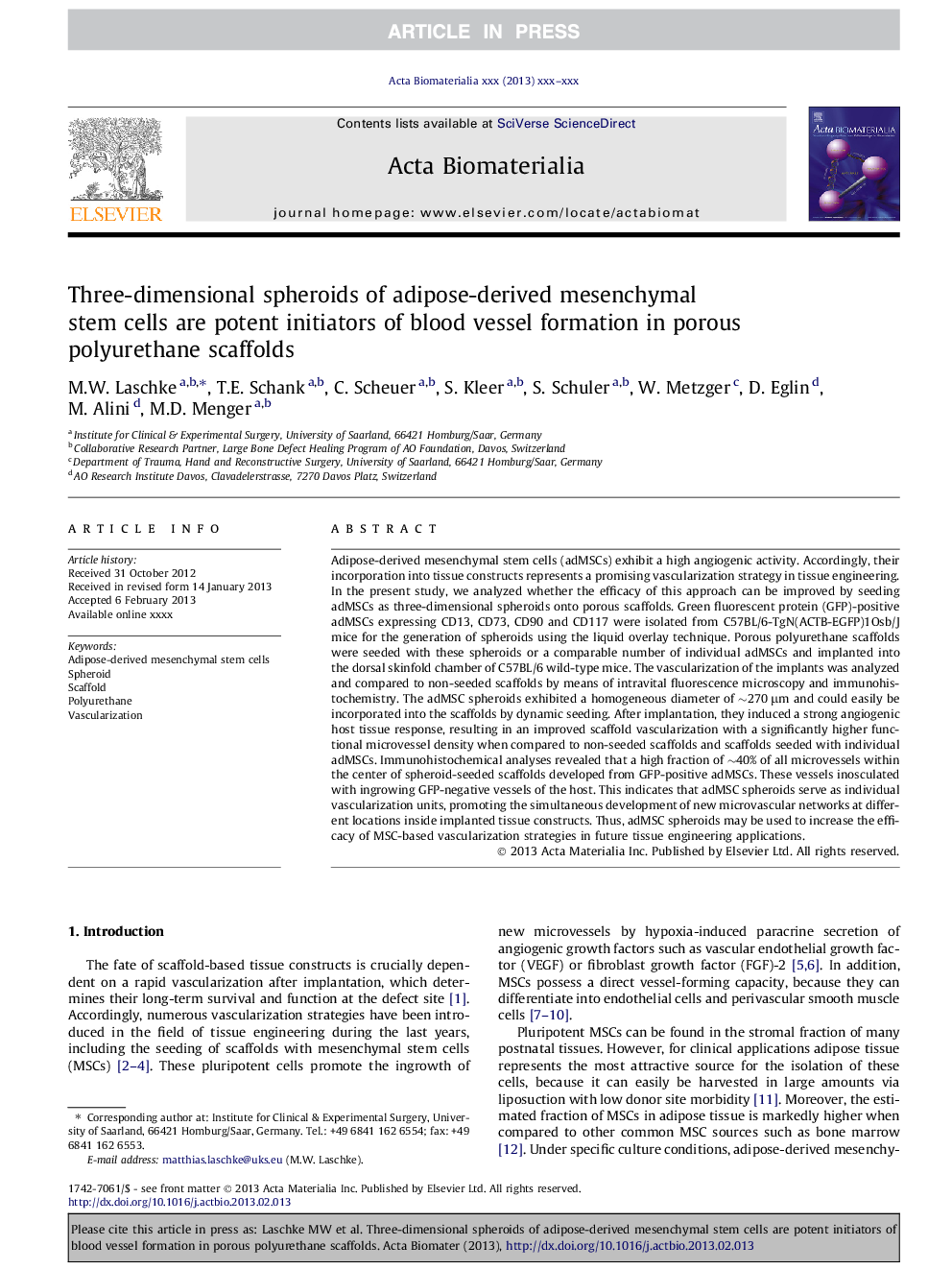| کد مقاله | کد نشریه | سال انتشار | مقاله انگلیسی | نسخه تمام متن |
|---|---|---|---|---|
| 10159543 | 50 | 2013 | 9 صفحه PDF | دانلود رایگان |
عنوان انگلیسی مقاله ISI
Three-dimensional spheroids of adipose-derived mesenchymal stem cells are potent initiators of blood vessel formation in porous polyurethane scaffolds
ترجمه فارسی عنوان
سلولهای بنیادی مزانشیمی مشتق شده از بافت سه بعدی سلولهای بنیادی مشتق از سلول های بنیادی مشتق از چربی هستند که از ایجاد کننده های رگ های خونی در داربست های پلی اورتان متخلخل هستند
دانلود مقاله + سفارش ترجمه
دانلود مقاله ISI انگلیسی
رایگان برای ایرانیان
کلمات کلیدی
موضوعات مرتبط
مهندسی و علوم پایه
مهندسی شیمی
بیو مهندسی (مهندسی زیستی)
چکیده انگلیسی
Adipose-derived mesenchymal stem cells (adMSCs) exhibit a high angiogenic activity. Accordingly, their incorporation into tissue constructs represents a promising vascularization strategy in tissue engineering. In the present study, we analyzed whether the efficacy of this approach can be improved by seeding adMSCs as three-dimensional spheroids onto porous scaffolds. Green fluorescent protein (GFP)-positive adMSCs expressing CD13, CD73, CD90 and CD117 were isolated from C57BL/6-TgN(ACTB-EGFP)1Osb/J mice for the generation of spheroids using the liquid overlay technique. Porous polyurethane scaffolds were seeded with these spheroids or a comparable number of individual adMSCs and implanted into the dorsal skinfold chamber of C57BL/6 wild-type mice. The vascularization of the implants was analyzed and compared to non-seeded scaffolds by means of intravital fluorescence microscopy and immunohistochemistry. The adMSC spheroids exhibited a homogeneous diameter of â¼270 μm and could easily be incorporated into the scaffolds by dynamic seeding. After implantation, they induced a strong angiogenic host tissue response, resulting in an improved scaffold vascularization with a significantly higher functional microvessel density when compared to non-seeded scaffolds and scaffolds seeded with individual adMSCs. Immunohistochemical analyses revealed that a high fraction of â¼40% of all microvessels within the center of spheroid-seeded scaffolds developed from GFP-positive adMSCs. These vessels inosculated with ingrowing GFP-negative vessels of the host. This indicates that adMSC spheroids serve as individual vascularization units, promoting the simultaneous development of new microvascular networks at different locations inside implanted tissue constructs. Thus, adMSC spheroids may be used to increase the efficacy of MSC-based vascularization strategies in future tissue engineering applications.
ناشر
Database: Elsevier - ScienceDirect (ساینس دایرکت)
Journal: Acta Biomaterialia - Volume 9, Issue 6, June 2013, Pages 6876-6884
Journal: Acta Biomaterialia - Volume 9, Issue 6, June 2013, Pages 6876-6884
نویسندگان
M.W. Laschke, T.E. Schank, C. Scheuer, S. Kleer, S. Schuler, W. Metzger, D. Eglin, M. Alini, M.D. Menger,
